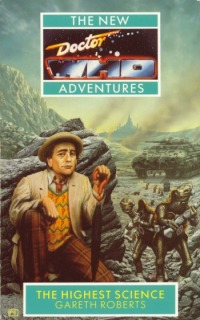BASIC PLOT
The Doctor is on the tail of a 'Fortean Flicker', a peculiar dimensional anomaly which throws out coincidences, when he gets caught up in a battle between vicious tortoises, a bunch of future hippies and commuters from the 20th century. Meanwhile, the Galaxy's most dangerous criminal is on the trail of something called The Highest Science.
DOCTOR
Seventh.
COMPANIONS
Bernice Summerfield.
MATERIALISATION CIRCUIT
p. 58 The TARDIS lands on Sakkrat AKA Hogsumm.
PREPARATORY READING
Benny's first two adventures - Love And War and Transit - get a few mentions here and there but really this is a standalone in the best sense of the word.
CONTINUITY REFERENCES
p.54 The Archive Tower is a (presumably rather large) building on Gallifrey.
p.59 The Doctor puts on his duffel coat, as seen in the Curse of Fenric.
p.61 When the Doctor is watching Captain Millennium, he notes that it is "almost like real life" when there is a scene that seems to be echoing Sarah-Jane's encounter with the eponymous metallic beast in Robot.
p.66 The Doctor mentions Charlie Parker. The seventh Doctor's love of jazz was established in Silver Nemesis.
p.71 Jan, the Travellers and the Hoothi are all from Love and War.
p.119 Witcher: "It's like something out of that rubbish they used to put on after Grandstand." Doctor Who used to be on after Grandstand.
p.124 The Doctor mentions having no contingency plans, a reference to the seventh Doctor's perceived role as a manipulator who uses time to cheat solutions.
p.168 Hooray for a mention of the sonic screwdriver and its absence since The Visitation. In the next book, The Pit, it suddenly re-appears for no adequately explored reason.
p.170 The Doctor is wearing a blue gemstone ring, but I don't know if this is a reference to another story.
p.171 Benny remembers the Heavenite observatory from Love and War and "Pointing a gun at the Doctor in a tunnel somewhere" from Transit.
p.183 The Doctor mentions that crossing the timelines can leave one sensitive to temporal disturbances, as seen in City of Death.
p.204 One of the guardians notices that something about Benny's name feels false: a reference to Benny's lack of a 'proper' professorship, as established in Love and War.
p.208 The Doctor mentions that he ran Taunton (in Somerset) for two weeks in the 18th century "and I've never been so bored".
OLD FRIENDS AND OLD ENEMIES
None. Even Virginia Woolf doesn't make an appearance.
NEW FRIENDS AND NEW ENEMIES
Introduced for the first time here are the Chelonians, who go on to appear in Zamper and The Well-Mannered War, and get mentions elsewhere. We're also introduced to Shelduker, the galaxy's most dangerous criminal; Gustav Ernst, the (in)famous explorer who gets mentioned in legend quite a bit, including through the Benny NAs; Rosheen and Klift, two immoral computer fraudsters; Sendei, Molassi and Rodomonte, three spaced out hippies from 2112; Checkley's World, home to some gruesome military-style genetic labs; The Cell, a rather revolting product of same; and a lot of out-of-place commuters whose fate is finally resolved in Happy Endings.
CONTINUITY COCK-UPS
- p.35 Benny says that she has travelled "about two hundred and thirty years into my future". Given that this story is blatantly set in 2680, this would mean Love and War is set in the year 2450. However, this had already been contradicted by Transit, which states that Benny is from the 26th century, and would later cause all sorts of confusion. It was later certified that Love And War was set in the year 2570, to fit in with Frontier In Space. See Lance Parkin's History of the Universe for a deeper analysis of this.
- The statement on p.205 that, in 5665, man has yet to master teleportation would seem to be contradicting the likes of The Seeds of Death (set c. 2000s).
PLUGGING THE HOLES [Fan-wank theorizing of how to fix continuity cock-ups]
- It's a bit of a mess all round but Lance Parkin had a stab at explaining things in Just War where Benny points out that there is no real galactic mean calendar, because of the dispersion of human interests. Good one Lance.
- The statement is from a Chelonian perspective and can easily be explained away by a) the 'parasite' colonies that the Chelonians like to attack have 'forgotten' teleportation or b) the Chelonians just having bad intelligence.
FEATURED ALIEN RACES
The Chelonians, giant warlike tortoises. Despite the cover, they rarely walk upright.
FEATURED LOCATIONS
The planet Sakkrat AKA Hogsumm.
IN SUMMARY - Klaus Pumpkin
A near-perfect novel with hardly any continuity references, proving that it can be done. The balance between Douglas Adams-style comedy (the Fortean Flicker is a retooling of the Improbability Drive) and serious drama is spot-on throughout, and in the Chelonians, Gareth Roberts creates the first truly memorable Virgin monster. Should be top of a prior-reading checklist for any prospective Doctor Who writer and only a true misery guts could find any fault with it.

